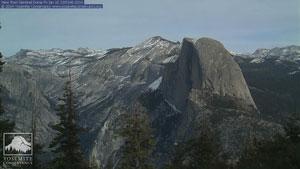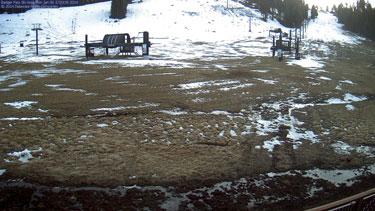Winter snows may have arrived in abundance in some parts of the country, but it's a different story so far in California, where the first snow survey of the season has already raised concerns for the coming summer. At Yosemite National Park, skiers have more immediate concerns, with the Badger Pass Ski Area not yet open for the season.
The importance of adequate snowfall in High Sierra areas such as Yosemite is summed up by the state's Department of Water Resources (DWR): "The snowpack normally provides about a third of the water we use in California as it slowly melts into streams and reservoirs in spring and early summer."
"More Bare Ground Than Snow"
That statistic alone explains why results of the year's first snow survey are prompting early worries in the state. Earlier this week the DWR reported that its "first snow survey of the winter found more bare ground than snow."
According to an agency spokesperson, "Manual and electronic readings record the snowpack's statewide water content at about 20 percent of average for this time of year." Figures are lowest in the northern mountains, which are at 11 percent of normal for the date. The last time California's statewide snowpack was this dry was in 2012, when it also was 20 percent of the historical average.
A Dry Trend, Winter and Summer
The readings today and in 2012 are also the driest on record, says the DWR, and concerns are compounded by last year's sparse rainfall; many areas of California ended calendar year 2013 with the lowest rainfall amounts on record.
Officials in the state are already planning ahead, in case the trend continues.
'While we hope conditions improve, we are fully mobilized to streamline water transfers and take every action possible to ease the effects of dry weather on farms, homes and businesses as we face a possible third consecutive dry year,' said DWR Director Mark Cowin. 'And every Californian can help by making water conservation a daily habit.'
That combination of low winter snow and skimpy rainfall at lower elevations during three consecutive years also raises worries about wildfires in a state where major incidents such as the Rim Fire last fall are still fresh in the minds of many locals. A recent report prepared for the San Francisco Public Utilities Commission says the cost of that one fire to local economies could be over $700 million.
Yosemite's Snow Courses Offer Valuable Historical Data
Measurements of the annual snowpack come from a combination of electronic sensors and old-fashioned hand measurements taken at specific spots in the mountains, known as snow courses. Data from Yosemite is especially valuable because it allows annual comparisons over a long period of time; records from some of Yosemite's snow courses date back to 1930.
While the year's state-wide water worries overshadow recreational issues, fans of the Badger Pass Ski Area are also feeling the pinch'the area has not yet opened for the season. The on-line "Badger Pass Ski Conditions and Snow Report" sums up the problem: "CLOSED UNTIL THERE'S MORE SNOW." Officials for the ski area are putting the best possible face on the situation, noting on the website, "We're just one good snow storm from opening for the 2013/14 Ski Season."

The High Sierra webcam view of Yosemite on January 10. Image from Yosemite Conservancy.
Still Plenty of Winter Ahead
There's certainly reason for that optimism, since there's still a lot of winter ahead, and it's true that one or two major storms can make a big difference in the situation. Ted Thomas is a spokesperson for the DWR, and he notes that half of the years with similarly dry first quarters caught up to average by the end of the season.
At present, however, the Yosemite webcams showing views of areas such as Yosemite Falls, Half Dome, the High Sierra and Badger Pass display very little of the eagerly-anticipated winter's snow.
There's certainly plenty to see and do in Yosemite, with or without snow, but If you're headed to the park in coming days in hopes of enjoying some snowshoeing and skiing, it would be a good idea to have a "Plan B."


 Support Essential Coverage of Essential Places
Support Essential Coverage of Essential Places







Comments
It's liable to be a very long, dry, hot summer throughout the west. In Utah we currently have only about 50% of the snow that should be on the ground. And our reservoirs ended last summer as low as they've been for a long time.
In Colorado, we have overflowing resevoirs and above average snow pack.
The ski areas at Snoqualmie Pass here in Washington state have just opened for the season this weekend, after we finally got our first good snowdump over the last couple of days. We've had a long dry spell each month in October, November, and December, which is just wrong for this part of the world.
And may I say that California's biggest issue is that the deserts of Southern California (including the LA basin) were never, ever intended to support millions of people?
Southern Cal was never "intended" to do anything... But exist. However you are right it is just wrong to build beyond the water capabilities Denver is doing the same thing.
Well, ec, us Utah, Arizona, Nevada and California denizens will have to thank you Colorado types next spring when some of that snow melts and temporarily adds a few inches to Lake Powell.
As unbridled urbanization covers this part of the country with homes, parking lots and businesses filled with more and more people, the future may become very interesting, indeed.
I'm still working on reading The Once and Future World, by J.B. MacKinnon (reviewed in Traveler a while ago). What a sobering book that is! It's an account of how we humans have a way of quickly forgetting the past and simply accepting a world that is slowly and steadily degrading around us while giving far too little thought to its future.
As what's supposed to be an intelligent species, we seem to have a lot of trouble using some of that intelligence to look back and learn from the past before we indulge ourselves in the present without any real concern for the future.
I remember hearing a horror story a long time ago -- about the time that Lake Powell was still filling for the first time back in 1968 when my Albright class spent a week camping at Padre Bay to learn all about "water recreation." We were told that Bureau of Reclamation water managers had just realized that evaporation pulled six inches of water every summer day from the entire surface of Lake Powell. Enough water, they said, to supply the daily needs of Los Angeles and Las Vegas at the time. We tested the statement with a few cans of water set on the beach and it seemed to be true.
Apparently no one had even thought of that while planning and building the big concrete plug. Then came the realization that the same thing happens on Lake Mead and all the puddles below Hoover Dam. Not only does it reduce water available, it also increases salinity and there was fear at the time that water from the Colorado would become dangerous for use in irrigation.
Yet at the same time, a new housing development was being built in Sin City that featured an artificial lake with a boat dock by each big home and a casino that boasted a 1000 foot tall fountain of water. (Or was that somewhere in Phoenix? I'm not sure now.)
Back then, the few people who tried to speak up and warn us were dismissed as nut cases who were somehow un-American. That still sounds awfully familiar, doesn't it? We don't seem to have learned much since then, have we?
I highly recommend that book to all Traveler's readers. But be warned. It will give you a very sore forehead because almost every page contains one of those things so obvious but overlooked that it will make you slap yourself between the eyes when you say, "Well, DUH!"
Very interesting post Lee, I will read the book. By the way, the chesseburger king, what was the end of the story?
Sorry, Ron, gonna have to read the book.
Ah, well, since it's you asking . . . . . it was the park's superintendent.
(Now you're really going to have to read it, aren't you? 'Cause I ain't a-gonna tell which superintendent it was . . . )